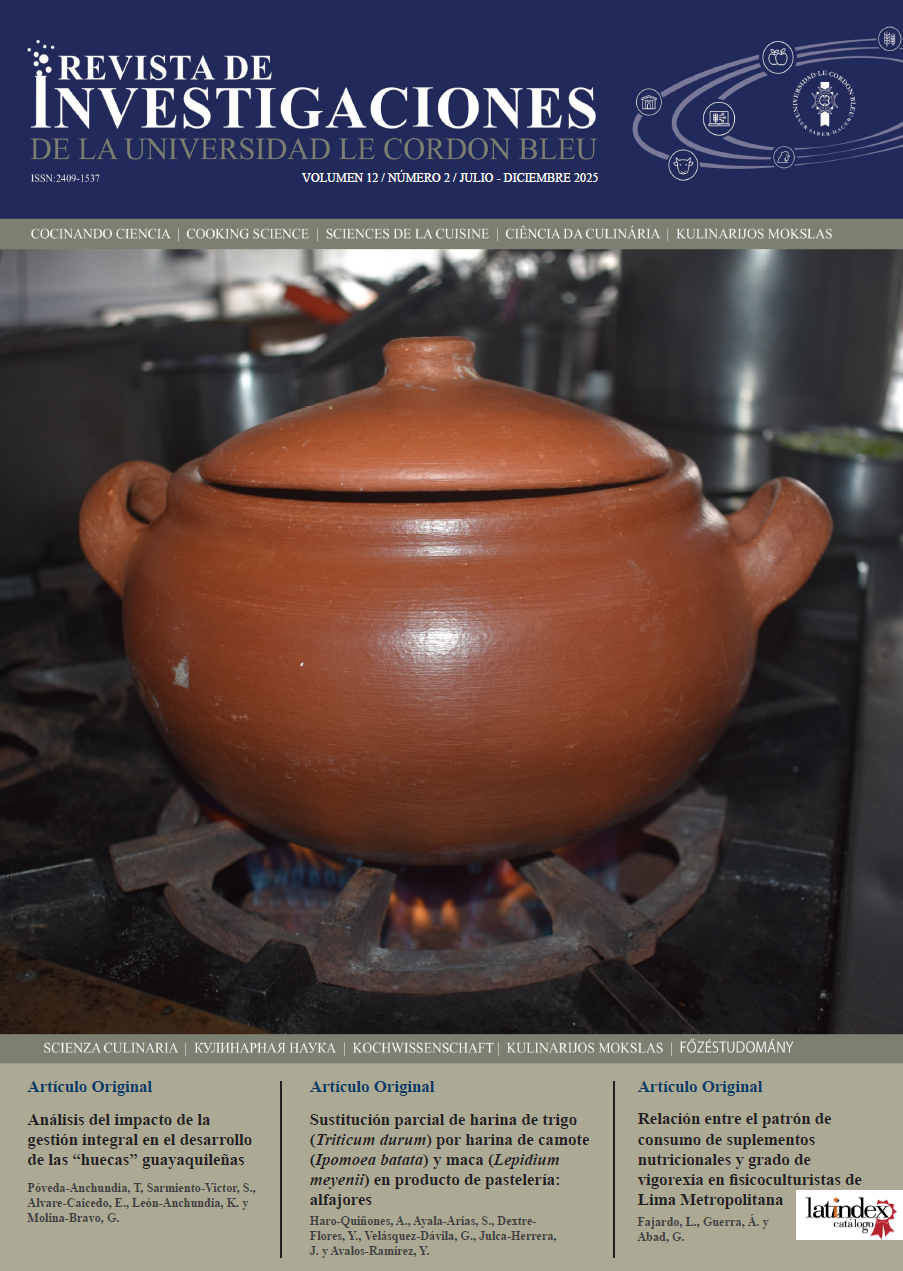Preparation of a jam endemic amazonian fruits and its sensory evaluation
Main Article Content
Abstract
The aim of this study was to produce a jam from endemic Amazonian fruits and evaluate its sensory attributes. The research was experimental, applying a completely randomized block design (DBCA) with seven treatments. The fruit trees were ungurahui, (Oenocarpus bataua var. Bataua), tumbo (Passiflora mollisima) and guava (Psidium guajava L.). Sensory evaluation was carried out using a nine-point hedonic scale. Chemical-proximal analysis and dietary fiber, physicochemical and microbiological tests of the selected formulation were carried out. ANOVA and Fisher were applied to verify a significant difference between the formulations and the Friedman test to determine preference with a statistical significance level p:<0.05. The F1 (100 % ungurahui), F2 (100 % tumbo); F3 (100 % guava), F4 (50 % ungurahui and 50 % tumbo), F5 (50 % ungurahui and 50 % guava), F6 (50 % tumbo and 50 % guava) and F7 (25 % ungurahui, 50 % tumbo and 25 % guava). There was a significant difference in the attributes odor, texture, and appearance. F7 (sample 978) was the most widely accepted, which presented soluble solids (66.8°Brix) and pH 3.2; the number of yeasts and molds was < 10 estimated. F7 complies with national and international regulations, as it is a safe product of nutritional quality.
Downloads
Article Details

This work is licensed under a Creative Commons Attribution 4.0 International License.
References
Codex S. Stan 79–1981 (1981). CODEX standard for jams (Fruit preserves) and jellies (Formerly CAC/RS 79-1976).
Córdoba, L., Gamboa, H., Mosquera, Y., Palacios, M., y Ramos, P. (2019). Productos forestales no maderables: uso y conocimiento de especies frutales silvestres comestibles del Chocó, Colombia. Cuadernos de Investigación UNED, 11 (2), 164-172. https://doi.org/10.22458/urj.v11i2.2304
Fernández, R., y Ramos, F. (2021). Efecto de la ingesta de frutas nativas como guanábana, sachatomate, aguaymanto y tumbo serrano sobre la glicemia a través del índice glicémico. Revista Española de Nutrición Comunitaria, 27(2) https://www.renc.es/imagenes/auxiliar/files/RENC_2021_2_art_8.pdf
Habtemariam, S. (2019). The chemical and pharmacological basis of guava (Psidium guajava L.) as potential therapy for type 2 diabetes and associated diseases. Chapter 9. In: Medicinal Foods as Potential Therapies for Type-2 Diabetes and Associated Diseases, 251–305. https://doi.org/10.1016/B978-0-08-102922-0.00009-2
Indecopi (2019). BioPat/Perú. Tema: Ungurahui. https://www.indecopi.gob.pe/documents/1902049/4367066/N%C2%B012_Ungurahui.pdf/af874f8e-1c26-67d0-352d-93ea866d201b
Lopa, J., Valderrama, M., León, N., Lazo, L., Llerena, J.P., Ballón, C., y Guija, E. (2021). Evaluación de la capacidad antioxidante y compuestos bioactivos de tumbo (Passiflora mollissima) y cerezo (Prunus serotina). Horizonte Médico (Lima), 21(3): e1365. https://doi.org/10.24265/horizmed.2021.v21n3.08
Loyola, N., y Acuña, C. (2021). Mermelada de arándano y frambuesa: evaluación sensorial, nutricional y de aceptabilidad. Magna Scientia UCEVA, 1,118–30. https://doi.org/10.54502/msuceva.v1n1a15
Luit , M., Betancur, D., Santos, J., y Cantón, C. (2019). Mermelada enriquecida con fibra dietética de cáscara de Mango (Mangifera indica L.). Tecnología en Marcha, 32 (1), 193-201. https://doi.org/10.8845/tm.v32.i1.4128
Ministerio de Salud (MINSA). (2008). 071-MINSA/DIGESA-V. 01. 2008. Norma sanitaria que establece los criterios microbiológicos de calidad sanitaria e inocuidad para los alimentos y bebidas de consumo humano. Resolución Ministerial (591-2008). http://www.digesa.minsa.gob.pe/norma_consulta/Proy_RM615- 2003.pdf
Naeem, M., Fairulnizal, M., Norhayati, M., Zaiton, A., Norliza, A., Syuriahti, W., Azerulazree, J., Aswir, A., y Rusidah, S. (2017). The nutritional composition of fruit jams in the Malaysian market. Journal of the Saudi Society of Agricultural Sciences, 16 (1), 89-96. http://dx.doi.org/10.1016/j.jssas.2015.03.002
Neyra, I., y Sosa, J. (2021). Néctar de “tumbo serrano” Passiflora tripartita Kunth edulcorado con miel de abeja: Cuantificación de la vitamina C y aceptabilidad organoléptica. Agroindustrial Science, 11(2), 141-147. http://dx.doi.org/10.17268/agroind.sci.2021.02.02
Norma Técnica Peruana NTP 203.047:1991 (revisada el 2017) Mermelada de frutas. Requisitos. [Instituto Nacional de la Calidad]. Norma Técnica Peruana-mermelada de frutas. (1), 12. Lima, Perú. 15 de marzo del 2017.
Palacios, D., Palacios, P., y Sosa, J. (2024). Evaluación fisicoquímica, sensorial y microbiológica de la mermelada de maracuyá (Passiflora edulis Sims) y camote, Piura. Revista De investigación Agropecuaria Science and Biotechnology, 4 (1), 34–41. https://doi.org/10.25127/riagrop.20241.968
Pereira, L., Gomes, D., Saraiva, K., Dantas, J., Silva, E., y Pereira, M. (2023). Exotic fruits patents trends: An overview based on technological prospection with a focus on Amazonian. Heliyon, 9, e22060. https://doi.org/10.1016/j.heliyon.2023.e22060
Quispe, R., Belizario, J., Quispe, H., Paredes, Y., Cahuana, P., Valles, M., y Caviedes, W. (2022). Capacidad antioxidante del néctar de Ungurahui (Oenocarpus bataua). Nutrición Clínica y Dietética Hospitalaria, 42 (1), 80-86. DOI: https://doi.org/10.12873/421quispe
Ríos, L., Graffton, E., Ruiz, R., Meza. C., González, A., Ferreiro. O., y Torres L. (2023). Reformulación Caracterización de la mermelada de Pomelo y Banana elaborada en el distrito de Coronel Oviedo, departamento de Caaguazú, Paraguay. Revista Sociedad Científica del Paraguay, 28(2), 250-268 https://doi.org/10.32480/rscp.2023.28.2.250
Shinwari, K., y Rao, P. (2018). Stability of bioactive compounds in fruit jam and jelly during processing and storage: A review. Trends in Food Science & Technology, 75, 181–193. https://doi.org/10.1016/j.tifs.2018.02.002
